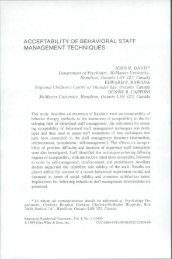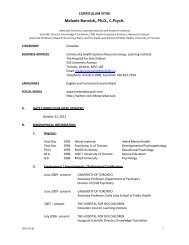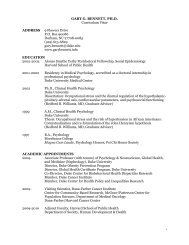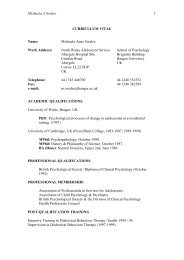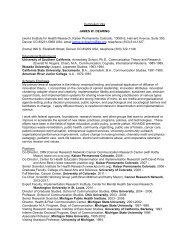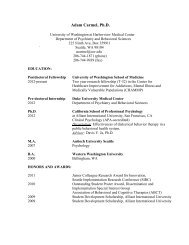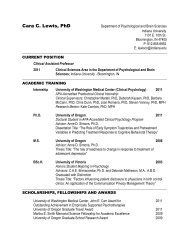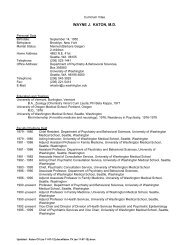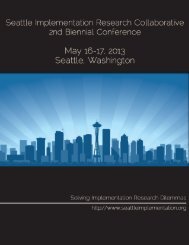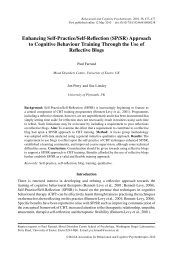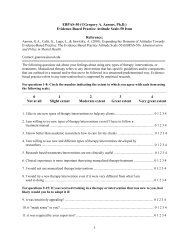The Cross-Level Effects of Culture and Climate in Human Service ...
The Cross-Level Effects of Culture and Climate in Human Service ...
The Cross-Level Effects of Culture and Climate in Human Service ...
You also want an ePaper? Increase the reach of your titles
YUMPU automatically turns print PDFs into web optimized ePapers that Google loves.
CULTURE AND CLIMATE 773<br />
systems. <strong>The</strong>re is evidence that work units such as case management teams can develop dist<strong>in</strong>ctive<br />
cultures <strong>and</strong> climates, creat<strong>in</strong>g multiple cultures <strong>and</strong> climates with<strong>in</strong> an organization (H<strong>of</strong>stede,<br />
1998). Multiple cultures <strong>and</strong> multiple climates develop as a function <strong>of</strong> the contexts with<strong>in</strong> which<br />
members function on a day-to-day basis (Stackman et al., 2000). Dist<strong>in</strong>ct cultures <strong>and</strong> climates are<br />
likely to emerge with<strong>in</strong> work units <strong>in</strong> an organization when the organization is large <strong>and</strong> the units work<br />
<strong>in</strong>dependently under separate supervisors <strong>in</strong> different geographical locations (Trice& Beyer, 1993).<br />
<strong>The</strong>se characteristics apply to the case management teams <strong>in</strong> this sample <strong>and</strong> contribute to multiple<br />
cultures <strong>and</strong> climates by def<strong>in</strong><strong>in</strong>g who <strong>in</strong>teracts with whom <strong>in</strong> the organization. Interactions with<strong>in</strong><br />
these teams are important to underst<strong>and</strong><strong>in</strong>g how multiple cultures <strong>and</strong> climates form because <strong>in</strong>teractions<br />
are the basis for the socialization <strong>of</strong> new members <strong>and</strong> for the <strong>in</strong>dividuals' <strong>in</strong>terpretations <strong>of</strong> the<br />
mean<strong>in</strong>g <strong>and</strong> impact <strong>of</strong> their work environment (Rentsch, 1990). While <strong>in</strong>teractions at work are not<br />
necessarily def<strong>in</strong>ed by formal work units, when the preponderance <strong>of</strong> organizational <strong>in</strong>teractions take<br />
place among the members <strong>of</strong> the same work unit under a dist<strong>in</strong>ct leader, the basis for a work unit culture<br />
<strong>and</strong> climate emerges.<br />
Assess<strong>in</strong>g multilevel relationships<br />
<strong>The</strong> boundaries that separate culture, climate, structure, <strong>and</strong> work attitudes are related to the multilevel<br />
nature <strong>of</strong> the relationships <strong>and</strong> to the composition models that l<strong>in</strong>k measures to constructs across levels<br />
<strong>of</strong> analysis (Kle<strong>in</strong> & Kozlowski, 2000a,b). Problems occur when variables such as culture are def<strong>in</strong>ed<br />
at higher levels (e.g., organizational work unit) <strong>and</strong> then measured with <strong>in</strong>dividual responses to surveys<br />
without aggregat<strong>in</strong>g the lower-level measures to work unit levels. Problems also occur when the relationships<br />
among variables are exam<strong>in</strong>ed at a s<strong>in</strong>gle level (e.g., <strong>in</strong>dividual) although some variables are<br />
work unit-level (e.g., structure) <strong>and</strong> some are <strong>in</strong>dividual-level variables (e.g., work attitudes). And<br />
other problems are created when measures <strong>of</strong> one construct, such as work attitudes, are comb<strong>in</strong>ed with<br />
measures <strong>of</strong> another, such as climate, with no explicit rationale. All <strong>of</strong> this underscores the need for<br />
greater clarity <strong>in</strong> specify<strong>in</strong>g the levels at which these variables operate, the explicit models used to<br />
create measures <strong>of</strong> higher-level variables, <strong>and</strong> the l<strong>in</strong>ks between lower-level <strong>and</strong> higher-level variables.<br />
L<strong>in</strong>ks between <strong>in</strong>dividual-level variables such as work attitudes <strong>and</strong> work unit-level variables such<br />
as organizational culture require statistical models that provide estimates <strong>of</strong> relationships between<br />
variables operationalized at different levels (James & Williams, 2000; Rousseau, 1985). Although<br />
cross-level <strong>in</strong>ferences can be made us<strong>in</strong>g a variety <strong>of</strong> approaches, hierarchical l<strong>in</strong>ear models analysis<br />
(HLM) was designed specifically for cross-level <strong>in</strong>ferences that l<strong>in</strong>k the characteristics <strong>of</strong> <strong>in</strong>dividuals<br />
to the characteristics <strong>of</strong> the groups <strong>in</strong> which they are nested (Bryk & Raudenbush, 1992).<br />
When HLM is applied to organizational research, questions about cross-level relationships <strong>in</strong> multilevel<br />
studies can be formulated as two-level r<strong>and</strong>om <strong>in</strong>tercept <strong>and</strong> r<strong>and</strong>om regression slope models<br />
(Bryk& Raudenbush, 1992; 84-86). <strong>The</strong> r<strong>and</strong>om <strong>in</strong>tercept model can be applied when key predictors<br />
<strong>in</strong>clude variables measured at both the <strong>in</strong>dividual <strong>and</strong> work unit levels <strong>and</strong> the outcome variable is<br />
measured at the <strong>in</strong>dividual level. If such data are analysed at the <strong>in</strong>dividual level only <strong>and</strong> the cluster<strong>in</strong>g<br />
<strong>of</strong> <strong>in</strong>dividuals by work unit is ignored, st<strong>and</strong>ard errors are underestimated <strong>and</strong> the risk <strong>of</strong> type I errors<br />
<strong>in</strong>flated. If such data are aggregated <strong>and</strong> analysed at the work unit level only (e.g., us<strong>in</strong>g unit means as<br />
outcomes), <strong>in</strong>dividual-level predictors are excluded <strong>and</strong> <strong>in</strong>efficient <strong>and</strong> biased estimates <strong>of</strong> organizational<br />
effects can result (Bryk& Raudenbush, 1992, p. 86). R<strong>and</strong>om <strong>in</strong>tercept models allow these problems<br />
to be avoided, <strong>and</strong> <strong>in</strong>dividual outcomes can be assessed as a function <strong>of</strong> the characteristics <strong>of</strong> the<br />
<strong>in</strong>dividual <strong>and</strong> their work units.<br />
Copyright ? 2002 John Wiley & Sons, Ltd. J. Organiz. Behav. 23, 767-794 (2002)




